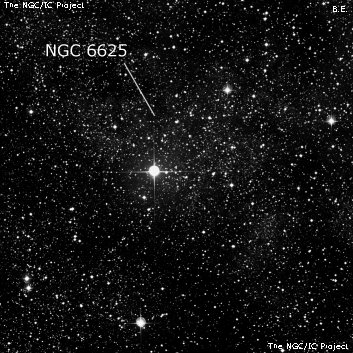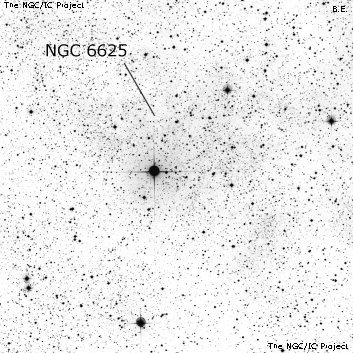NGC/IC Project Restoration Effort
(This is a very very beta version)
NGC6625


Basic Information
Location and Magnitude
Right Ascension: 18:23:12.8
Declination: -12:0:47
Constellation: SCT
Visual Magnitude: 9.0
Historic Information
Discoverer: Herschel J.
Year of discovery: 1826
Discovery aperture: 18.3
Observational
Summary description: Cl, lC, lRi, st 11…12
Sub-type: OCL
Corwin's Notes
=====
NGC 6625. JH's RA is marked uncertain in his 1833 PT catalogue where he
describes it only as "A loose straggling cluster of stars 11 .. 12 m." In the
sweep (number 34 on 31 July 1826), he gives the RA to a full minute of time
only and marks it "+-"; there is no wire or chronometer beat given. M 16 =
NGC 6611 is 4 minutes 20 seconds west, and NGC 6639 is 8 minutes 15 seconds
east in the sweep (before the wire corrections are applied), so the RA is
approximately correct. JH's description in the sweep is the same as he
published, but he has two additional words that I cannot make out. Another
curiosity of the observation is HD 169033 with V = 5.7; it is within 1.5
arcminutes of JH's published nominal position for the cluster, yet is not
mentioned at all in the sweep (unless the two unreadable words are a reference
to it).
There is no immediately obvious cluster at his clearly uncertain position, but
about two arcmin northwest there is a clump of stars, four arcmin by two
arcmin in size, that might be his object. This is on the southeastern edge of
a much larger clump (roughly 10 arcmin by 8 arcmin) that could also be JH's
object. Neither is particularly striking, but the former has been identified
as a real cluster. Since it stands out a bit more, and might make an
impression during a sweep -- and for lack of anything better -- I've adopted
it as N6625, though with a colon. The larger clump gets a question mark, but
on reflection, it might be more in keeping with JH's description of "loose"
and "straggling".
-----
In "Star Clusters", Brent Archinal chooses an even larger group (39 arcminutes
across) centered on the HD star. Given that JH describes the cluster as
"loose" and "straggling", Brent's suggestion might be JH's object. But JH's
magnitude estimate of the brightest stars at 11 is in conflict with the
magnitude of HD 169033, so I can't put much weight on Brent's suggested size
or position.
On further reflection, however, I've changed the question mark and colon on my
original two choices so that the larger object is now more likely to be JH's
cluster. This, of course, is simply a suggestion. JH has just not left us
enough to tell for sure what he saw here.
Steve's Notes
=====
NGC 6625
17.5" (8/3/97): at 100x, appears to be a Milky Way field in a large triangular region roughly bordered by mag 5.7 HD 169033 star at the SE vertex, a mag 8 star ~12' NW and a mag 9 star ~9' W. This identification is uncertain as the region is completely indistinguishable from surrounding fields in star density and does not have any resemblance to a cluster although the Milky Way background seems locally brighter (also, JH does not mention the mag 5.7 star). At 220x, there is a fairly well-defined edge to portions of this Milky Way background and there is a small extension to the west near the star at the NW vertex. Listed as nonexistent in RNGC, though may be a true cluster. Located just east of Sh 2-54, a large, faint HII complex and the slightly enhanced Milky Way background may be caused by the glow of Sh 2-54.



